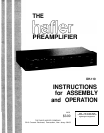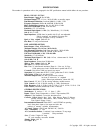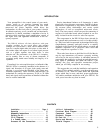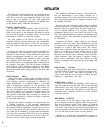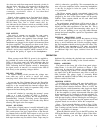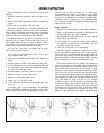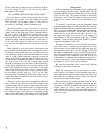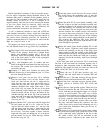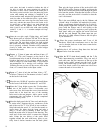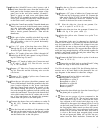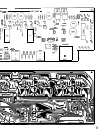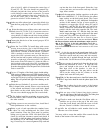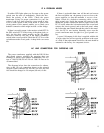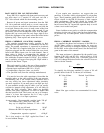fects
that can result from unpowered electronic circuits in
the tape decks when they are connected to the Recording
Outputs, it is recommended that tape recorders be
switched on when the preamplifier is in use. This is a
commonly overlooked cause of less-than-ideal
preamplifier performance.
Signals at these outputs are at line input level (phono
signals are first amplified and equalized). These outputs
are unaffected by external processing circuits, or by the
DH-110’s Mono, Filter, Tone or Volume controls. Only sig-
nals indicated by the Selector switch are available, includ-
ing the other tape input, so tape copying is provided using
either recorder as a source.
LINE OUTPUTS
Two pairs of outputs are provided for your power
which is otherwise a possibility. We recommend that you
turn off power amplifiers before connecting headphones,
or that they be plugged in before the system is switched on,
as a precaution.
The Direct outputs provide conventional signal levels
independent of the headphone circuit. If headphones are
plugged in, the level of the Direct output will be greatly
reduced. These outputs should not be used when head-
phone use is anticipated.
The performance specifications will be met so long as
the input impedance of the power amplifier is
10K
ohms or
higher, and the cable capacitance is less than
1Onf.
This is
no problem with typical interconnecting cables up to 10
feet. If you
are
planning to use very long cables between
preamp and power amplifier, special low capacitance cable
can be obtained.
amplifier connection. The set
labelled
‘Via Phones’ is
EXTERNAL PROCESSING LOOP
suggested for those who regularly listen through head- ‘Send’ is an output at line level for the purpose of driving
phones as an alternative. These are wired so that when
an external signal processor such as an equalizer, time
headphones
are
plugged in, the signal is disconnected from
delay, or noise reduction unit. Like the recording outputs,
the power amplifier. Two purposes are thus served. Since
the load impedance should not be less than
10K
ohms. The
many headphones require fairly high volume control
set-
EPL ‘Return’ input impedance is 33K ohms, and should
tings, you avoid inadvertent high signal levels to your
also be at line level. The EPL Return can also function as
speakers. And a power amplifier which is turned off
can-
an additional high level input, switched from the front
not degrade the quality of signal to the
headphones-
panel.
OPERATION
When you turn on the DH-110, power is also applied to
the switched AC outlets on the back panel. One of the red
LEDs on the front panel will light, indicating that the
preamp is functioning. Typically, it will be the left-most
LED, indicating that the Selector switch is determining
the signal source. At turn-off, it is normal for the LED to
fade slowly as the operating voltages decline.
DELAYED TURN-ON
An internal muting circuit prevents the voltage tran-
sients which may occur at turn-on or turn-off from causing
annoying noises, blown fuses or damaged loudspeakers.
At turn-on, the Line Outputs (but not the Recording
Outputs or EPL Send output) will be held near ground po-
tential for a few seconds until the internal voltages have
stabilized, and the unit is ready for operation. Only a faint
output can be heard during this time.
At turn-off, whether by operating the preamp’s power
switch, or as a result of external AC failure (a ‘brown-out’,
pulled plug, or blown house fuse), the line output will be
instantaneously lowered. Following power interruption,
the muting circuit will initiate a few seconds delay before
allowing full signal at the line outputs.
SIGNAL SELECTION
Your choice of signal sources is usually indicated by the
Selector Switch, identified by the adjacent lighted LED.
This switch passes line level signals direct to the Record-
ing Outputs and to the EPL Send output as well as to the
Mono switch and subsequent line amp controls. Either or
both tape recorders may record this source. Tapes may be
duplicated by selecting the playback tape recorder on the
Selector switch, and recording on the second machine.
PHONO AMPLIFIER
The button in the lower left of the front panel selects
either Phono 1 (in the OUT position) or Phono 2. The
switch may be operated to compare two cartridges while
music is playing, but if them is no cartridge connected to
one input, noise or RF interference may cause a small au-
dible transient. The phono signal is accurately RIAA
equalized and amplified 34dB (at 1kHz), then passed to the
Selector switch at line level.
MONITOR SWITCH
To facilitate tape recording with tape decks which pro-
vide an independent monitoring facility, the DH-110 pro-
vides this second selection function. When it is OFF, the
regular Selector switch determines what signals are heard.
When the Monitor switch is turned to either Tape 1 or Tape
2, the line amplifier is quietly disconnected from the signal
being recorded, and is connected to the tape playback in-
stead. This enables direct comparison of the signal source
with the taped replica, without affecting the recording pro-
cess. Tape decks which do not provide separate record and
playback heads are not able to utilize this comparison.
Note: Do not turn the Monitor switch to Tape 1 if the
Selector is also set to Tape 1. Likewise avoid simultaneous
Tape 2 settings on both switches. Feedback will occur, and
there is a possibility of damage.
When the Monitor switch is not in the OFF position, the
LED at the Monitor switch will light, in place of the Selec-
tor LED, reminding you that tape playback has been
selected.
5



